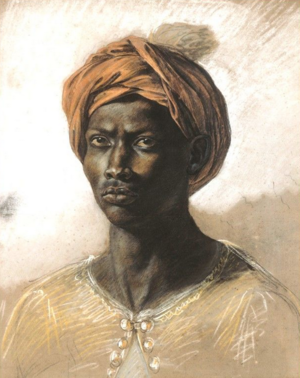Sunt Rhashashrveesa
Sunt Rhashashrveesa Dukabagma, also known as Rhashashrveesa or sometimes simply Rhashasha, was an administrator of Cananganam's oversea territories in the late 800s during the Early Medieval Period. He was born to a Mablic family as Jaomo Jo-Aircaat but later was granted the name Sunt Rhashashrveesa Dukabagma to better legitimize his place in Cananganam's higher caste society by the Cananganamese Emperor. Rhashasha commanded several voyages throughout the Asura Ocean and had made landfall in Atsiq in 862 during his Second Voyage, where he originally landed in Shyoria and eventually met with the Osverali court. He later would be granted governance of Cananganam's tributaries in the Asura ocean, as well as the primary diplomat to these territories.
Capture and Enslavement
Rhashasha's early life before the age of 9 is not very well known. He along with his older siblings were captured by Canamic slave raiders when they were captured while fixing the ropes of their fishing nets. After their capture, they were brought to a slave market in Sabha where Rhashasha and his sisters were sold to an administrator of the city. He was taught to read and write by the administrator as an indentured clerk, while his sisters held more housekeeping roles of the administrator's residence. When he was around age 13, one of his sisters had given birth at a time when the Imperial government was in interim. The child born was believed by officials to be the reincarnation of the Emperor which immediately elevated Rhashasha's status as well as his siblings as members of the Imperial Court.
Adulthood
With the elevation of his status, he was groomed to be a member of the court, but having his nautical background and his knowledge of logistics through clerical work for the administrator, he was made an administrator of the ports of Daktuva, handling the tariffs on goods traveling from Dhwer and the rest of Nagu. His relation to the new Emperor gave him a degree of autonomy with his work, where he proceeded to prepare an expedition to explore the Asura Ocean. Initially, several administrators had attempted to block the diversion of resources for these expeditions, however, as the Emperor grew older and was able to intervene, he was made the Grand Admiral of the Canamic fleet giving him free reign over the maritime actions and for trade expeditions.
Expeditions
Rhashasha had made several plans but the most intriguing to him was rumors of "paradise islands" to the West that fishermen had supposedly come across, claimed to have been untouched and pristine by other empires. Alternatively, there was also the rumored "snake sea" to the East that was said to carry metals, spices, and other lucrative trade goods. Rhashasha, believing the paradise islands may hold value that the Eastern sea may not.
1st Expedition
In 856, Rhashasha and his expedition set off from a port in the north of Cananganam and traveled directly West with the goal being to discover and document the paradise islands. The expedition had spent about a month at sea before landing on several islands which were then named the Asoraanata, meaning Westerlies in Cananganamese.
We had travelled 34 days at sea and have come across foreign islands. The crew were initially excited by our voyage but that had dwindled as time passed. Hope seems to have entered the hearts of our crew as we come across these islands. The locals were visible from the shore and while we could not speak with them as their language was foreign to us, they seem excited to see our crew and the tools that we had aboard our ships. We tried to make exchange and gave them some of our cloths in return for food that our crew may need.
— Sunt Rhashashrveesa Dukabagma
The expedition continued throughout the islands and towards the end of the journey, they took several individuals back to Cananganam to learn more of the peoples and the language, as well as for religious conversion. The expedition returned in 858 where they returned to much praise.
2nd Expedition
With the results of his first expedition granting much praise, the individuals taken from the Asura Islands gave hints of a larger island chain to the north which Rhashasha wished to pursue. After spending a few years preparing his next expedition, he set sail in a more Northwesterly direction with more supplies than the first expedition. After a month, his ships had made sight of the Southern chain of the Atameng islands which he had named the Maiminata which he claims comes from the local language.
